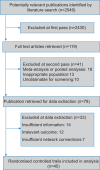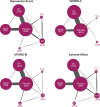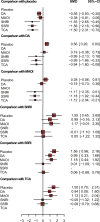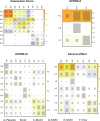Efficacy of antidepressive medication for depression in Parkinson disease: a network meta-analysis
- PMID: 28562526
- PMCID: PMC5459691
- DOI: 10.1097/MD.0000000000006698
Efficacy of antidepressive medication for depression in Parkinson disease: a network meta-analysis
Abstract
Background: Parkinson disease (PD) was considered as the 2nd most prevalent neurodegenerative disorder after Alzheimer disease, while depression is a prevailing nonmotor symptom of PD. Typically used antidepression medication includes tricyclic antidepressants (TCA), selective serotonin reuptake inhibitors (SSRI), serotonin and norepinephrine reuptake inhibitors (SNRI), monoamine-oxidase inhibitors (MAOI), and dopamine agonists (DA). Our study aimed at evaluating the efficacy of antidepressive medications for depression of PD.
Methods: Web of Science, PubMed, Embase, and the Cochrane library were searched for related articles. Traditional meta-analysis and network meta-analysis (NMA) were performed with outcomes including depression score, UPDRS-II, UPDRS-III, and adverse effects. Surface under the cumulative ranking curve (SUCRA) was also performed to illustrate the rank probabilities of different medications on various outcomes. The consistency of direct and indirect evidence was also assessed by node-splitting method.
Results: Results of traditional pairwise meta-analysis were performed. Concerning depression score, significant improvement was observed in AD, MAOI, SSRI, and SNRI compared with placebo. NMA was performed and more information could be obtained. DA was illustrated to be effective over placebo concerning UPDRS-III, MAOI, and SNRI. DA demonstrated a better prognosis in UPDRS-II scores compared with placebo and MAOI. However, DA and SSRI demonstrated a significant increase in adverse effects compared with placebo. The SUCRA value was calculated to evaluate the ranking probabilities of all medications on investigated outcomes, and the consistency between direct and indirect evidences was assessed by node-splitting method.
Conclusion: SSRI had a satisfying efficacy for the depression of PD patients and could improve activities of daily living and motor function of patient but the adverse effects are unneglectable. SNRI are the safest medication with high efficacy for depression as well while other outcomes are relatively poor.
Conflict of interest statement
Declaration of interest: There were no conflicts of interest in the conduct, analysis, and publishing of this manuscript among study authors.
The authors have no conflicts of interest to disclose.
Figures






Similar articles
-
Comparative efficacy and acceptability of drug treatments for Parkinson's disease with depression: A systematic review with network meta-analysis.Eur J Pharmacol. 2022 Jul 15;927:175070. doi: 10.1016/j.ejphar.2022.175070. Epub 2022 Jun 1. Eur J Pharmacol. 2022. PMID: 35659968
-
Efficacy and tolerability of antidepressants in Parkinson's disease: A systematic review and network meta-analysis.Int J Geriatr Psychiatry. 2018 Apr;33(4):642-651. doi: 10.1002/gps.4834. Epub 2017 Dec 13. Int J Geriatr Psychiatry. 2018. PMID: 29235150 Free PMC article.
-
Antidepressants and Risk of Sudden Cardiac Death: A Network Meta-Analysis and Systematic Review.Med Sci (Basel). 2021 Apr 23;9(2):26. doi: 10.3390/medsci9020026. Med Sci (Basel). 2021. PMID: 33922524 Free PMC article.
-
Pharmacological treatment of Parkinson disease: a review.JAMA. 2014 Apr 23-30;311(16):1670-83. doi: 10.1001/jama.2014.3654. JAMA. 2014. PMID: 24756517 Review.
-
Combination therapy with monoamine oxidase inhibitors and other antidepressants or stimulants: strategies for the management of treatment-resistant depression.Pharmacotherapy. 2015 Apr;35(4):433-49. doi: 10.1002/phar.1576. Pharmacotherapy. 2015. PMID: 25884531 Review.
Cited by
-
Treatment of Apathy in Parkinson's Disease and Implications for Underlying Pathophysiology.J Clin Med. 2024 Apr 11;13(8):2216. doi: 10.3390/jcm13082216. J Clin Med. 2024. PMID: 38673489 Free PMC article. Review.
-
Non-Pharmacological Interventions for Depression and Anxiety in Parkinson's Disease.J Parkinsons Dis. 2024;14(s1):S135-S146. doi: 10.3233/JPD-230228. J Parkinsons Dis. 2024. PMID: 38607762 Free PMC article. Review.
-
Locus coeruleus injury modulates ventral midbrain neuroinflammation during DSS-induced colitis.Res Sq [Preprint]. 2024 Mar 12:rs.3.rs-3952442. doi: 10.21203/rs.3.rs-3952442/v1. Res Sq. 2024. PMID: 38559083 Free PMC article. Preprint.
-
Serotonin as a biomarker of toxin-induced Parkinsonism.Mol Med. 2024 Mar 1;30(1):33. doi: 10.1186/s10020-023-00773-9. Mol Med. 2024. PMID: 38429661 Free PMC article.
-
Pharmacological and Non-Pharmacological Treatments for Depression in Parkinson's Disease: An Updated Review.Medicina (Kaunas). 2023 Aug 12;59(8):1454. doi: 10.3390/medicina59081454. Medicina (Kaunas). 2023. PMID: 37629744 Free PMC article. Review.
References
-
- Kataoka H, Sawa N, Sugie K, et al. Can dopamine agonists trigger tactile hallucinations in patients with Parkinson's disease? J Neurol Sci 2014;347:361–3. - PubMed
-
- Takahashi H, Kamata M, Yoshida K, et al. Remarkable effect of milnacipran, a serotonin-noradrenalin reuptake inhibitor (SNRI), on depressive symptoms in patients with Parkinson's disease who have insufficient response to selective serotonin reuptake inhibitors (SSRIs): two case reports. Prog Neuropsychopharmacol Biol Psychiatry 2005;29:351–3. - PubMed
-
- Kostic V, Dzoljic E, Todorovic Z, et al. Fluoxetine does not impair motor function in patients with Parkinson's disease: correlation between mood and motor functions with plasma concentrations of fluoxetine/norfluoxetine. Vojnosanit Pregl 2012;69:1067–75. - PubMed
Publication types
MeSH terms
Substances
LinkOut - more resources
Full Text Sources
Other Literature Sources
Medical

